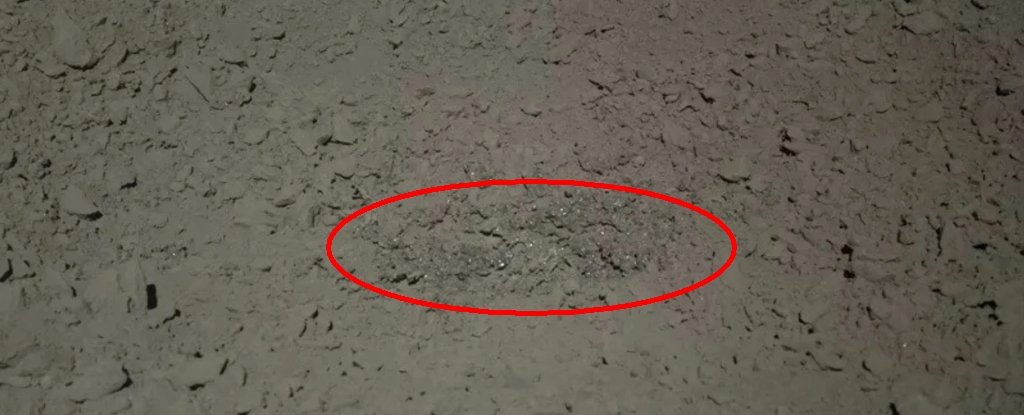
Posted on 07/08/2020 11:44:38 AM PDT by Red Badger

A peculiar "gel-like" substance the Chinese Yutu-2 rover discovered in a small impact crater on the far side of the Moon last year has now been identified. According to analysis of the images, and comparison with Apollo samples here on Earth, it's exactly what you'd expect to find on the Moon: rock.
More specifically, it's rock that was melted together - likely in the heat of a meteorite impact - to form a dark green, glossy, glassy mass.
"Chang'e-4 rover discovered a dark greenish and glistening impact melt breccia in a crater during its traverse on the floor of Von Kármán crater within the South Pole Aitken (SPA) basin on the lunar farside," the researchers wrote in their paper.
"It was formed by impact-generated welding, cementing, and agglutinating of lunar regolith and breccia."
The glistening substance was first imaged by Yutu-2 in late July of 2019, and revealed the following month on the Yutu-2 drive diary published by Chinese government-sanctioned science outreach blog Our Space.
It was described as "gel-like", which is an unusual descriptor for something found on the Moon, given the lunar landscape is a very dry, dusty sort of place. Images that were released later revealed something that was indeed glossy, but very likely not at all moist - consistent with initial speculation that the substance was impact melt, not gelatinous.
A more detailed analysis of images taken using Yutu-2's Panoramic Camera, Visible and Near-Infrared Imaging Spectrometer (VNIS) and hazard avoidance camera supports this hypothesis.
In particular, the images from the VNIS allowed Sheng Gou of the Chinese Academy of Sciences and his colleagues to break down the light reflected off the substance and determine its chemical composition, in addition to that of the surrounding regolith (the rubbly dust and gravel).
According to this analysis, the regolith is made up predominantly of plagioclase (around 45 percent), pyroxene (7 percent) and olivine (6 percent) - pretty standard Moon-stuff. The glassy substance, however, was a bit more difficult to unravel, possibly due to the poor light. They could only make out plagioclase, at an abundance of around 38 percent.
This is not dissimilar to the surrounding regolith, suggesting that the composition may be similar. The researchers were also able to determine that the material is dark greenish in colour, and measures approximately 52 by 16 centimetres (20 by 6 inches).
It is very similar to two samples retrieved by the Apollo 15 and 17 missions, Lunar Sample 15466 and Lunar Sample 70019 respectively. Both these samples, retrieved from impact craters, are classified as breccia - a type of rock made up of chunks of rock cemented together by finer material. In both cases, the chunks are lunar regolith, and the cement is black glass.
The researchers conclude that the substance was likely created during a meteorite impact. When the meteorite struck, it melted some of the regolith, which mixed with unmelted regolith to form a breccia.
But this did not necessarily take place in the crater in which the material was found. That's because the regolith is probably a mixture of material from two different craters - so it's possible the material was formed in a different crater and ejected, landing where, ultimately, Yutu-2 found it.
Additionally, we have the size of the crater - about 2 metres (6.7 feet) across. The estimated diameter of an impactor that would create a crater that size is only 2 centimetres (0.8 inches) - way too small to create an impact melt 52 by 16 centimetres.
"Hence, the impact melt breccia was not likely formed in situ in the crater where it was found, but was very likely emplaced in a different event and was ejected to the 2-metre fresh crater," the researchers wrote.
There are some limitations. We don't have an actual sample to analyse. As noted, the light was poor; and Yutu-2 moved on from the site in late August of last year, so a second set of images is unlikely to be obtained.
Nonetheles, these results are pretty amazing based on the data we have. And we can finally rest safe in the knowledge that we don't have to worry about a pool of mysterious Moon mucus.
The research has been published in Earth and Planetary Science Letters.
Apollo 18?
A little dab will do ya’
Great, now I can sleep at night once again.
gel like is a journalistic ignorance. Vitreous rather than gelatinous would be better
Poetic license..................
...it's rock that was melted together - likely in the heat of a meteorite impact - to form a dark green, glossy, glassy mass.
Thanks Red Badger. [singing] green green, the greenest rock, and the far side of the Moon...
|
Must be Space Jelly because Space Jam doesn’t shake like that
Soylent green?
Purell
Knew someone who had a monkey once. It formed lots of dark green, glossy, glassy masses.............................
Hand sanitizer?........even the Moon has Covid-19!...............
One of my favs...............Loved her in ‘Bad Teacher’!.......
The supposedly awesomely smart Chinese finally have something rolling around on the moon. LOL

I see what you did there...
What’s remaining off the Lewinski Blue Dress.

Disclaimer: Opinions posted on Free Republic are those of the individual posters and do not necessarily represent the opinion of Free Republic or its management. All materials posted herein are protected by copyright law and the exemption for fair use of copyrighted works.